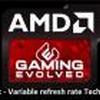As you guys know AMD announced a competitive and may I say very cheap solution to tackle Nvidia's Gsync recently, it goes under the name FreeSync. The problem thus far is that monitors need to support a new protocol, and for a monitor protocol you need to talk to VESA to make it a standard. Well, good news AMDs FreeSync will be adopted by VESA.
So the graphics card is running a dynamic device and that the monitor is static Hz, these two don't really match together. Now the irony is that the solution to solve all this is so very simple in its bare essence. G-Sync and FreeSync will get rid of screen tearing and sync stuttering/pulsing.
Basically the protocol will be embeded into DisplayPort 1.2a, there is a catch though, manufacturers of monitors are free to decide wether or not to support the technology.
If you like to learn more about the 'overall' technology, have a peek at our G-Sync article. Both companies use different methodologies, but the outcome is nearly similar.


